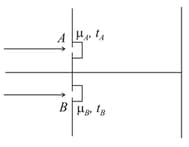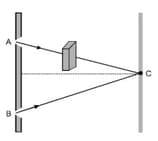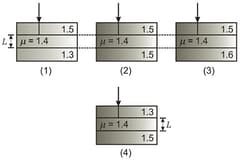Interference Due to Thin Films
Interference Due to Thin Films: Overview
This topic covers concepts, such as, Constructive Interference of Refracted Waves from Thin Film for Normal Incidence & Destructive Interference of Refracted Waves from Thin Film for Normal Incidence etc.
Important Questions on Interference Due to Thin Films
When Two waves of same amplitude add constructively, the intensity becomes _____
What is the main principle used in Interference?
_____ does not show any interference pattern?
How do you find the path difference between two waves?
How is the difference in paths taken by two originally in phase light waves related to whether they interfere constructively or destructively?
What is the path difference between two light waves?
What is the path difference between two light waves?
A soap film of refractive index 1.33 is illuminated by the light of wavelength at an angle of 45 degrees. There is complete destructive interference. For, find the thickness of the film.
Given Refractive index = 1.33, i =
Thin film interference happens with________.
What is destructive interference thin film?
When light is incident on a soap film of thickness , the wavelength of light reflected maximum in the visible region is . The refractive index of the film will be:
Interference fringes were produced in Young's double slit experiment using light of wavelength When a film of thickness was placed in front of one of the slits, the fringe pattern shifted by a distance equal to fringe-widths. The refractive index of the material of the film is
InYoung's double slit experiment, a mica sheet of thickness and refractive index is introduced in the path of ray from the first source . By how much distance the fringe pattern will be displaced :
In , let and be two slits as shown. Thin films of thickness and and refractive indices and are placed in front of and respectively. If then the central maxima will

If thickness of thin film is made extremely thin then film will appeared :-
In Young's experiment, monochromatic light is used to illuminate the two slits and . Interference fringes are observed on a screen placed in front of the slits. Now if a thin glass plate is placed normally in the path of the beam coming from the slit, then which of the following explanation holds true with regards to fringes/fringe width?

Consider a film of thickness L, as shown in four different cases below, Notice the observation of film with perpendicularly falling light. Mark the correct statement(s).

(Take )
Interference pattern is observed at 'P' due to superimposition of two rays coming out from a source 'S' as shown in the diagram. The value of ' ' for which maxima is obtained at 'P' is :
(R is perfect reflecting surface) :

In a Young's double slit experiment, two wavelengths of 500 nm and 700 nm were used. What is the minimum distance in mm from the central maximum where their maximum coincide again? Take D/d =103. Symbols have their usual meanings.
